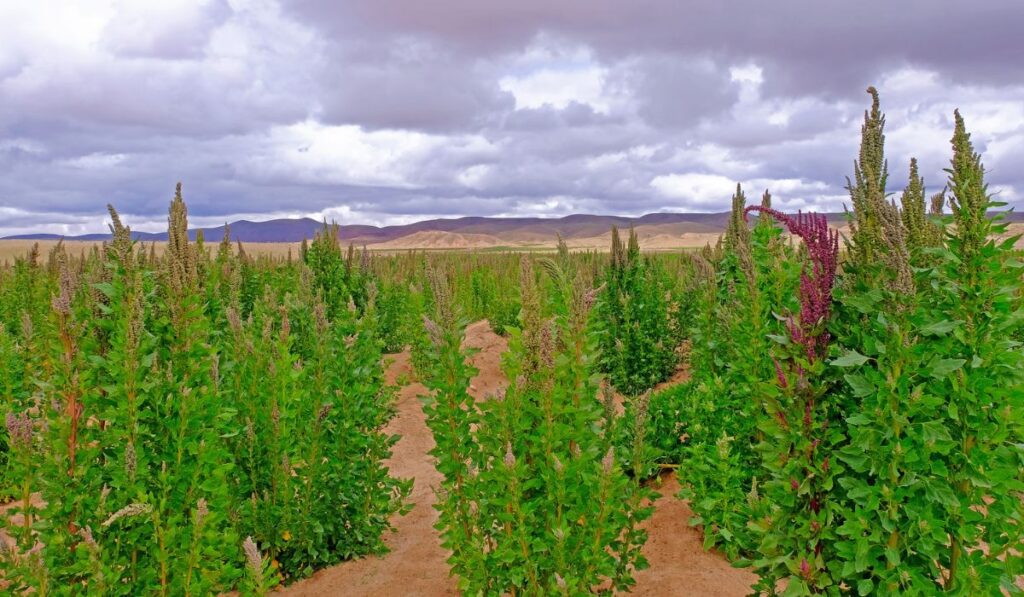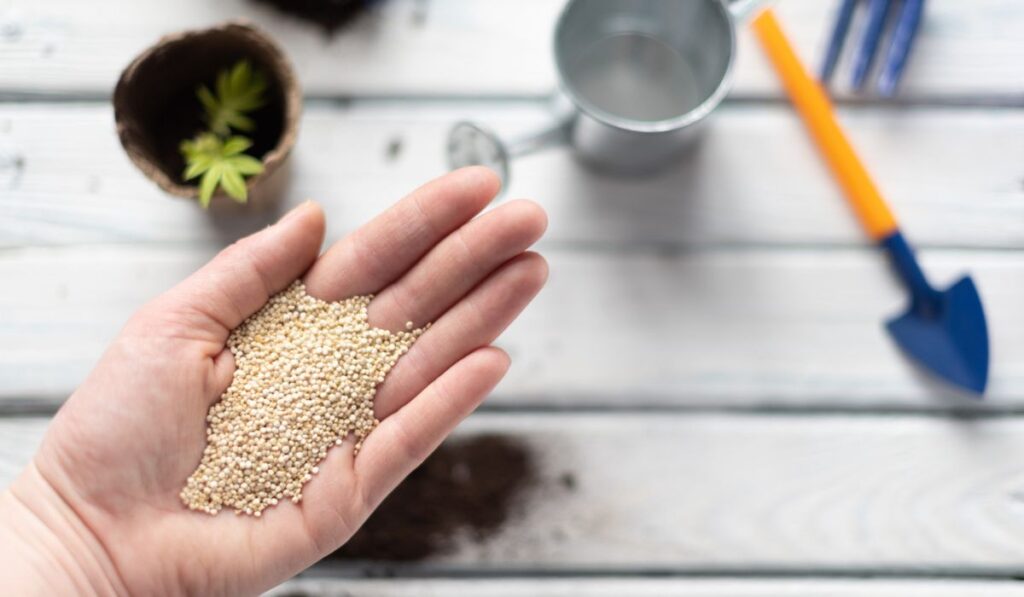Quinoa is a favorite crop among cool-climate gardeners, and this beautiful annual can make an excellent addition to your vegetable or flower garden. The tall plants have silvery green leaves and brilliant red, gold, or pink seed heads whose tiny seeds are rich in protein. Great, but how do you plant and care for quinoa?
You can plant quinoa by sowing the seeds directly in your well-prepared garden once the risk of spring frost has passed. Alternatively, start the seeds indoors in containers and harden them off before transplanting. Caring for the plants involves watering, thinning, and staking them.
Quinoa does well in cool temperatures with consistently moist conditions and plenty of sunlight. Moreover, quinoa plants are easy to grow and require little maintenance. Let’s get started so you know about planting and caring for this beautiful vegetable.
What is Quinoa?

Quinoa (Chenopodium quinoa) is an annual flowering plant of the amaranth family grown for its edible seeds. Not only are the seeds packed with protein, but they’re also rich in B vitamins, dietary fiber, and minerals in tremendous amounts not seen in many grains.
The plant is indigenous to the Andes of South America and has been cultivated in the region for centuries. It thrives best in areas whose summer temperatures don’t go beyond 32 degrees Celsius ( 90 ℉).
However, plant breeders have developed cultivars that do well in warmer climates and coastal regions. Most quinoa varieties will grow 4 to 6 feet tall and usually produce seeds in black, light tan, or red shades.
The plants need a long season to encourage optimal growth and maturity, with most varieties getting ready for harvest 3 to 4 months after seeding.
Quinoa is also related to lamb’s quarters, a common weed popular among foragers. And just like lamb’s quarters, you can eat quinoa’s tender leaves. You can cook the leaves like you prepare spinach, or you can cook them in pasta, dips, and casseroles. You might even enjoy them in raw salads.
Please note, however, that quinoa leaves contain high levels of oxalic acid that can increase the risk of developing kidney stones in sensitive people.
When is a Good Time to Plant Quinoa?
The best time to plant quinoa is in the spring, 2 or 3 weeks after the danger of frost has passed. Remember, quinoa seedlings have a very low tolerance for cold, and you should wait until the last spring frost is over. Only mature plants will give you an easy time harvesting after a light frost in the fall.
You sow the seeds in uniform rows, cover them lightly with soil, and keep the soil moist well until the seeds burst to life.
How to Plant Quinoa

You can either plant quinoa by sowing the seeds directly in your garden or starting them indoors and transplanting the seedlings later. If you live in a short-season climate, it’s good to give the plants a good head start indoors.
How to Plant Quinoa by Direct Seeding
Quinoa likes a site with plenty of sunshine and fertile, well-drained soil. To improve the soil, you can prepare the site mid-spring using compost or aged manure. You can also use a slow-release organic fertilizer.
Wait until the last spring frost has passed and the soil is warm enough in the 60 ℉ (15 ℃) range. Then, sow the tiny seeds a little of ¼ inch deep and space them 2 to 3 inches apart in raised beds, where they do best.
You should always ensure the seedbed is moist until the seeds sprout in about four days to a week. For best results, you can lay a row cover over the bed to help conserve soil moisture. Be sure to lift it daily to check if the plants need more water, and remove it once the seeds germinate.
How to Start Quinoa Seeds Indoors
Since quinoa grows relatively fast, you shouldn’t seed it indoors too early. Instead, sow the seeds in pots or growing trays 4 to 5 weeks before the last expected spring frost. Moreover, you don’t want to plant them too deeply, as they only need a thin layer of soil.
Place the growing containers under your grow lights or in a sunny window. Expect the seedlings to sprout in aboutfive5 days, and you should keep the lights on for 14 to 16 hours a day. Also, keep an eye on the soil moisture, watering the soil when it feels dry to the touch.
Once the seedlings have developed their second set of true leaves, you can use a diluted water-soluble fertilizer. And once the frost has passed, harden off the seedlings and transplant them into your garden.
How to Care For Quinoa After Planting
Growing quinoa in your vegetable garden won’t be much hassle as it’s a low-care plant. However, these are the tips to care for the plants for healthy growth and a substantial yield of seeds:
Thining
Thin the seedlings 12 to 18 inches apart, depending on the type you’re growing. You can space shorter varieties 12” apart, while tall varieties do well with 1 ½ feet between the plants.
But if you’re growing quinoa for the greens rather than as a seed crop, thin the plants 8 to 10 inches apart. You can eat the thinning in salads.
Watering
Water the plants occasionally for increased growth and yield, but stop doing so at the end of the summer. The seedheads usually start developing at this time. Once the plants are mature, they’ll have vigorous root systems that make them hardy enough to withstand drought conditions.
Staking
Stake the plants when they’re 2 to 3 feet tall for additional support. Quinoa plants can grow quite tall, even reaching 6 feet! However, this will make them vulnerable to toppling in gusty winds. Instead, use fiberglass or bamboo stakes and secure the plants with garden twine.
Weeding
Weed the plants to prevent competition for moisture, light, and nutrients. For example, quinoa doesn’t like to sit alongside other botanical relatives like lamb’s quarters, so pull out any that pops up.
The risk here is that it can cross with lamb’s quarters, and the resulting seeds won’t grow true to the type for future crops.
Other Tips
While quinoa plants need rich soils with high organic matter, they don’t require fertilization during the growing period. Moreover, they grow well in bright, sunny locations. But if the heat intensity increases during the day, you can provide some partial shade.
